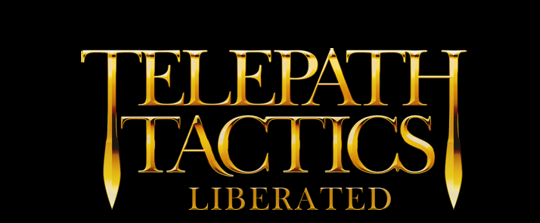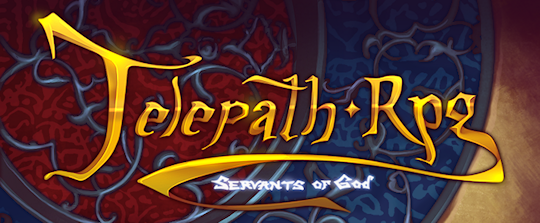In my last opinion piece, I provoked a certain subsection of the world of RPG enthusiasts by slaughtering a particularly sacred cow: the D&D-style combat system. A surprising number of people wrote in agreeing with me. Predictably, however, others responded in one of two ways: (1) “So you think a real-time, action-centered combat system is better?” or (2) “Name an RPG combat system that’s better!”
The answer to (1) is easy. No, I don’t think real-time is better. Just the opposite: I prefer turn-based combat in my RPGs. Of the six games I’ve released since I started designing games, five use turn-based combat, and I’m working on two more with turn-based tactical combat for good measure. That should probably tell you something about my tastes.
The answer to (2) is more complicated. I don’t think that there is just one way to do a turn-based RPG combat system correctly. I’ll avoid naming particular games, since I don’t want to give the impression that all RPGs should employ combat in the style of any one particular game. I will, however, discuss the features that good turn-based tactical combat systems have in common, and cite games that successfully employ them.
The Four Virtues of a good tactical turn-based combat system
If you’ve read my last article, this list is going to look familiar. A good tactical turn-based combat system exemplifies the following Four Virtues:
(1) Emergent complexity. It creates complex gameplay out of a comparatively simple set of rules.
(2) Clarity. The immediate consequences of various tactical decisions are made clear to the player ahead of time.
(3) Determinism. The system is sufficiently deterministic that skilled play using a proper strategy will nearly always result in victory.
(4) Tactical tools. If there is some randomness in the system (which there will be in most cases), the player has sufficient tactical tools at her disposal so that skilled play will almost always trump bad luck.
How can we employ these features?
The Four Virtues of a good tactical turn-based combat system are closely interconnected: with a handful of simple rules, a turn-based combat system can exponentially increase its tactical possibility space, thereby achieving the goals of both emergent complexity and skill-based outcomes to battles.
Clarity, in turn, arises organically if you do this properly: which is to say, if you don’t achieve complexity by overloading your combat system with arcane rules, the player should quickly be able to understand exactly how her actions will play out in combat, allowing her to plan ahead and strategize. (Clarity also depends upon good interface design and appropriate visual cues to the player, but those things are basic to good game design in general, and aren’t worth discussing here.)
So let’s get specific. There is a veritable cornucopia of techniques that game developers have used in the past to make their turn-based combat systems sparkle with tactical possibilities, and I want to see new RPGs start using them with greater regularity.
Perhaps the most powerful technique is simply to
(1) Use space. Adding a spatial dimension to combat increases its complexity exponentially without making it substantially harder for the player to understand. Most people have played games like Candyland or Monopoly, to say nothing of Checkers and Chess. Everyone (even your mom) intuitively understands the concept of moving pieces between spaces.
By using space in your battles, you add a new dimension to combat both figuratively and literally: the concept of attack range comes into play, and the player gains direct control of actions like fleeing and protecting weaker characters behind stronger ones.
Of course, you aren’t required to have a grid-based (or hex-based) map with movable characters to create a good tactical combat system, but it’s an awfully effective way to introduce complexity using simple rules. This alone will put your game far ahead of most jRPG combat systems.
Then again, spatial combat is not exactly a huge achievement: virtually every western RPG has this in one form or another. Let’s be a little ambitious. Here are 11 other techniques for achieving the Four Virtues that have been consistently overlooked not just in jRPGs, but in western RPGs as well:
(2) Give the player at least six characters. This one is absolutely key, and yet most western RPGs of the past 20 years have missed it. Imagine playing chess with only four pieces–you’d be looking at a game with greatly reduced tactical complexity and far less interesting matches.
Putting more characters under the player’s control pays great dividends in terms of tactics. More characters means that the player can be expected to handle much more involved combat scenarios, and becomes responsible for keeping more characters alive. This naturally gives rise to dilemmas about how to balance multiple objectives with minimal losses, which in turn make combat more interesting.
Also, with more characters under the player’s control, each individual character can be much more specialized. Speaking of which…
(3) Specialize the characters. How dull would chess be if it were played entirely with knights, or bishops? Make sure characters of different classes serve different battlefield roles; don’t just make them all fighters with different hit points, armor and spells.
If you differentiate your classes successfully, your player will have to think carefully about which characters should perform which actions during battle. The Fire Emblem series, especially, does a great job with this.
(4) Specialize the enemies. This should be obvious: if every enemy is a melee bruiser with magical attacks, your player has no reason to prioritize one enemy over the others. Give enemies distinctly different capabilities, weaknesses, and battlefield roles.
(5) Variable distance. Do not always begin battles with enemies 1 turn or less away from melee range! Spacing them out a little will give the player more flexibility to try out ranged tactics, as well as pressuring the player take cover from or flank enemy ranged units.
(6) Directional facing. Make it so that characters are easier to hit and/or suffer additional damage when attacked from behind or the sides. Doing so amplifies the importance of positioning in close quarters, adding another wrinkle to the player’s considerations. It also has a side effect of making faster-moving characters more dangerous, as well as increasing the effectiveness of flanking and pincer movements.
(7) Variable terrain. Used properly, terrain can add new dimensions to player considerations about character positioning, creating natural choke points on the battlefield, providing cover, or even providing bonuses or penalties to the characters who stand on it (Advance Wars and the Disgaea games serve as excellent examples of the latter).
Terrain can also serve as a point of character specialization, with certain classes performing better on certain squares (or being uniquely able to move through them).
(8) Manipulable terrain. But why stop there? Let the player actually manipulate terrain during the battle. Temporary terrain creation occasionally appears in western RPGs in the form of walls of fire, walls of ice, and traps that players can place to form barriers or choke points. Destructible terrain in RPGs is rare, however, and most created terrain lasts for only a short duration.
We can do better than that. Give the player meaningful flexibility to shape the battlefield, creating new avenues of attack and closing off existing ones. This will cause your combat system to accommodate more creative tactical thinking. The player won’t just be thinking about how to place her characters to best make use of the environment: she’ll also be thinking about how to change the environment itself to create those opportunities in the first place.
(9) Resource management. This appears in nearly all western RPGs to a limited extent, mostly in the form of budgeting gold, conserving magic points and hoarding scrolls and potions. However, this standard RPG implementation of resource management isn’t usually too important at the combat level–it’s typically a broader challenge spanning a whole foray into a given area.
To liven up particular combat encounters, use a system that requires players to balance more powerful attacks against other priorities on a turn-by-turn basis. Action Point systems (e.g. the kind used in X-Com: UFO Defense and the first two Fallouts) are great for this, forcing the player to weigh a variety of factors all at once when deciding on character actions. Also good are systems where most powerful abilities use large amounts of magic points, but magic points regenerate over time (e.g. Tactics Ogre: Let us Cling Together).
(10) Give units multiple attack options. This dovetails nicely with resource management: giving each character the option of more effective but more expensive or risky attacks expands the player’s tactical options greatly. Should the player pin her hopes on her character landing a more powerful blow, or should she have him get in a quick jab and leave some resources for the character to defend himself afterwards?
These sorts of small-scale dilemmas are the bread and butter of a satisfying tactical combat system. (Fallout and Fallout 2 provide a great example of how to use this technique.)
(11) Support multiple objectives. I mean this not just in the sense that your combat system should challenge the player with different win and loss conditions; I mean this in the sense that multiple different objectives (not of the win/loss variety) should be able to coexist within any given battle in your combat system.
This is a simple extension of the idea that a good RPG should have choices with consequences: there should be post-battle consequences for what happens during battles as well. Did she hit a town guard with a misguided arrow? Make it so the player is wanted for assault. Did she successfully protect the manor of the richest man in town? Make the rich NPC give the player a reward after the battle.
Aside from the obvious benefits such a feature creates for immersion, it also creates a richer tactical experience for the player. The goal becomes not just to win–the goal becomes to win while accomplishing as many side objectives as possible.
Because of the effort involved in setting up custom objectives for each battle, you might instead choose to set up your combat system with persistent side objectives such as maintaining character morale (X-Com) or gathering certain resources that can only be gathered during battle (treasure chests in Fire Emblem, captured majin in Eternal Poison).
In Telepath RPG: Servants of God, for instance, slain characters can only be resurrected through the use of soul charges, which in turn can only be obtained by using one character’s Soul Suck ability on a critically injured enemy during combat. The player is forced to periodically use the character who can Soul Suck in order to maintain a supply of soul charges; and within particular battles, she must weigh the risk of keeping an enemy alive long enough to harvest it against the reward of having a one-shot chance to raise a slain character later on.
(12) Allow delayed attacks. Delayed attacks add a new twist to the turn-based formula, allowing characters to attack even when it isn’t their turn anymore. Counterattacks are an effective (and, at least among Japanese strategy RPGs, common) form of delayed attack. By allowing melee units to only retaliate against melee units and ranged units to only retaliate against units at range, counterattacks further complicate unit match-ups and enforce character specialization. (Players will want to attack melee units at range, and vice versa.)
Attacks of opportunity are another form of delayed attack that encourage the player to pay extra attention to her own unit movement and placement, juggling the costs and benefits of expending all of a character’s actions during its turn versus keeping some in reserve in case enemies wander into attack range later on. These are, in short, an extension of the resource management concept we talked about in #9 above. (You can see the attack of opportunity mechanic at work with X-Com’s reaction fire system and with the guard command in Pool of Radiance.)
Interestingly, a couple of upcoming indie games (Frozen Synapse and Fray) actually use delayed attacks as the centerpiece of their entire combat systems. In these games, combat focuses around the player’s ability to guess which units will be where, when.
Well, that’s twelve. I know of no RPG combat system that uses all twelve of these techniques at once, and to be honest, I’m not entirely sure that I’d want one to! That would be one heck of a complicated combat system. But in an environment of RPGs whose combat systems err on the side of simplicity, that’s the sort of problem I really wouldn’t mind having.
UPDATE: Part three has now been posted.





